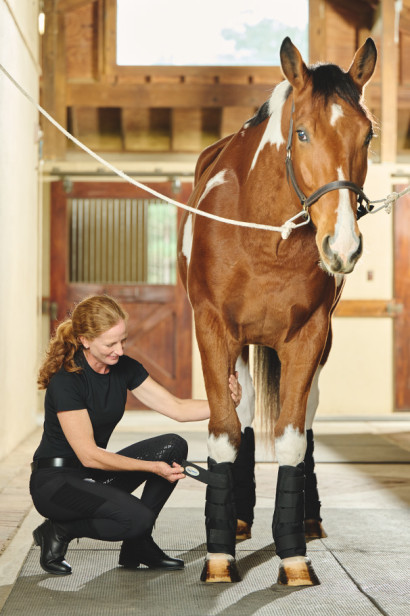Assessing the Performance of Laser Therapy in Horse Treatment for Injury Rehab
The analysis of laser therapy's performance in equine injury rehabilitation depends upon numerous elements, consisting of recuperation time, pain reduction, and cells regeneration. Scientific researches suggest noteworthy improvements in conditions like tendonitis and osteoarthritis, credited to improved cellular function and raised ATP manufacturing. Veterinarians often observe premium outcomes with laser therapy contrasted to standard methods, positioning it as a crucial aspect in equine treatment. The necessity for constant surveillance and tailored treatment plans can not be overstated. What particular scientific proof sustains these cases, and how do veterinarians execute these procedures in technique?
Understanding Laser Therapy
Laser treatment has actually come to be a pivotal tool in vet medication, specifically in the treatment of equine conditions. Understood for its non-invasive nature and effectiveness, laser treatment entails the application of certain wavelengths of light to promote tissue repair work and reduce swelling. This healing modality is increasingly favored for its ability to accelerate the healing procedure in steeds struggling with a selection of bone and joint injuries and chronic conditions.
The primary system behind laser treatment is its ability to boost mobile features. Additionally, laser therapy advertises vasodilation, boosting blood flow and oxygen delivery to damaged cells, hence expediting healing.
In equine medication, laser treatment is specifically useful for problems such as tendonitis, osteo arthritis, and injury recovery. The technique is lauded for its pain-relieving properties, enabling horses to restore wheelchair and function a lot more swiftly. Vets additionally value its marginal negative effects compared to various other therapy modalities, making it a reputable and risk-free choice for equine treatment.

Exactly How Laser Therapy Works

Upon absorption, these photons cause a collection of biochemical modifications, enhancing mitochondrial function and resulting in boosted adenosine triphosphate (ATP) production. This rise in ATP increases cellular metabolism, advertising tissue repair and regrowth. Furthermore, laser therapy regulates inflammatory reactions by affecting cytokine degrees and decreasing oxidative stress, consequently minimizing pain and swelling.
One more significant facet of laser therapy is its duty in improving microcirculation. The treatment promotes vasodilation, boosting blood flow and oxygen distribution to damaged cells (Equine Therapy). This assists in the removal of mobile debris and sustains the proliferation of fibroblasts and collagen synthesis, vital for wound healing
Clinical Evidence
The effectiveness of laser treatment in equine treatment has been corroborated via numerous medical researches, showcasing its healing potential across a range of conditions. A research study carried out by Turner et al. (2012) showed that steeds treated with low-level laser treatment (LLLT) for ligament injuries showed accelerated healing compared to those getting standard therapies.
Similarly, study by Johnson and associates (2015) concentrated on equine muscle mass injuries, revealing that laser treatment considerably expedited muscle mass fiber regeneration and minimized muscle rigidity. Medical analyses have revealed that laser therapy can relieve chronic problems such as osteoarthritis.
Vet Insights

Vets additionally value the versatility of laser therapy. It can be employed for a variety of conditions, from superficial injuries to much deeper bone and joint injuries. Dr. Emily Brown highlights its energy in dealing with problems like tendonitis and osteoarthritis, where traditional therapies usually fail. She directs out that laser treatment can be tailored to the particular needs of each horse, ensuring optimal end results.
In addition, vets value the ability to integrate laser treatment with various other therapy techniques. This multimodal method can enhance overall treatment efficiency, supplying a detailed service for equine rehabilitation. Such recommendations from skilled experts underscore the expanding approval and application of laser therapy in equine medication.
Practical Factors To Consider
A crucial element of implementing laser treatment in equine therapy involves comprehending the practical considerations that guarantee its effectiveness and security. Firstly, it is important to select the proper laser gadget, as various kinds differ in wavelength, power, and penetration deepness. Equine Therapy. Veterinarians have to be well-versed in these criteria to tailor therapy protocols click over here properly to every injury kind
Additionally, the frequency and period of laser therapy sessions require careful planning to take full advantage of healing benefits while lessening any possible negative effects. Regular monitoring of the steed's reaction to therapy can direct needed adjustments in the therapy program. Establishing a risk-free and regulated setting during treatments is likewise my latest blog post vital to protect against accidental exposure to laser discharges, which could hurt both the equine and the trainer.
Educating and certification of personnel administering laser therapy are vital to make certain correct technique and to copyright safety standards. Additionally, preserving precise records of each session, including laser settings and observed outcomes, is vital for assessing the total performance of the therapy and for making data-driven choices.
Verdict
Laser treatment has arised as an efficient modality in equine injury recovery, providing substantial advantages in recovery time, discomfort relief, and cells healing. For optimum results, continual tracking and individualized therapy protocols continue to be important in leveraging the complete capacity of laser treatment in equine care.
Comments on “Equine Therapy: How It Assists Build Self-confidence and Psychological Toughness”